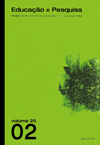O livro didático na educação infantil: reflexão versus repetição na resolução de problemas matemáticos
DOI:
https://doi.org/10.1590/S1517-97021999000200006Palabras clave:
Educação infantil, Livro didático, Problemas matemáticos, Ensino de matemáticaResumen
O artigo analisa livros didáticos de matemática utilizados em salas de educação infantil, especificamente o tópico de resolução de problemas de estrutura aditiva. Foram examinadas doze coleções de livros, a partir de quatro eixos: a forma de introdução aos conceitos de adição e subtração; os tipos de problemas propostos; a utilização das ilustrações nos enunciados dos problemas; e o tipo de registro solicitado às crianças. Constatou-se que os livros didáticos analisados apresentam uma pequena variedade em relação à estrutura dos problemas. Assim, problemas envolvendo adição se limitam às estruturas de combinação e transformação e a maioria dos problemas de subtração restringe-se à estrutura de transformação. Em relação às ilustrações, observou-se que este recurso é bastante utilizado para fornecer os dados no enunciado do problema. Notaram-se, ainda, vários casos em que a própria ilustração fornece a resposta. Quanto ao tipo de registro, evidenciou-se que este se limita, geralmente, à solicitação da escrita dos dados e da resposta do problema em espaços previamente determinados. Freqüentemente é indicado o sinal da operação esperada para a solução do problema. Conclui-se que os livros didáticos de pré-escola analisados pretendem trabalhar com resolução de problemas, no entanto, as situações propostas são repetitivas e não estimulam o desenvolvimento e o confronto de estratégias diversas por parte das crianças.Descargas
Los datos de descarga aún no están disponibles.
Descargas
Publicado
1999-07-01
Número
Sección
Artículos
Licencia
Los conceptos emitidos en los artículos son de exclusiva responsabilidad de sus autores y no reflejan necesariamente la opinión de la redacción.
Está permitida la reproducción total o parcial de los trabajos, siempre y cuando se indique explícitamente la fuente.
Cómo citar
O livro didático na educação infantil: reflexão versus repetição na resolução de problemas matemáticos . (1999). Educação E Pesquisa, 25(2), 69-82. https://doi.org/10.1590/S1517-97021999000200006



